 Doctor Strange #1 (#391) — Writer: Mark Waid; Art/Colors: Jesus Saiz
Doctor Strange #1 (#391) — Writer: Mark Waid; Art/Colors: Jesus Saiz
Captain America #703 — Writer: Mark Waid; Art: Leonardo Romero with Alan Davis and Mark Farmer; Colors: Jordie Bellaire with Irma Kniivila
Ant-Man and the Wasp #1 — Writer: Mark Waid; Art: Javier Garron; Colors: Israel Silva
Ant-Man and the Wasp: Living Legends #1 (of 1) — Writer: Ralph Macchio; Art: Andrea di Vito; Colors: Laura Villari
 True Believers: Ant-Man and the Wasp — The Birth of Giant-Man #1 (of 1) — Writer: Stan Lee; Art: Jack Kirby with Don Heck
True Believers: Ant-Man and the Wasp — The Birth of Giant-Man #1 (of 1) — Writer: Stan Lee; Art: Jack Kirby with Don Heck
Longtime comics scripter Mark Waid gets a hat trick this week, with three different Marvel comics. Doctor Strange #1 (#391, for obsessive collectors like you and me) begins his latest tenure on that title, with a seven-page flashback showing Strange at his peak, and then a flash-forward to today, where he’s mysteriously lost connection to his powers, leaving Earth vulnerable to all those magical/supernaturtal incursions he’s supposed to be protecting us from. Part of Waid’s appeal is that his stories are so rich in character, continuity  and clever plotting, and this is no exception; although the “Strange loses magic” bit is old hat — it was the driver behind both Jason Aaron’s and Donny Cates’s recent tenures on the book — this goes in a different direction than they did (as in, Strange goes in search of alien Sorcerers Supreme, in a Tony Stark-provided spaceship) and shows some promise, providing it doesn’t go on too long. Going in unexpected directions has been the theme of Waid’s latest Captain America arc, too — set 100 years from now, it involves one of Cap’s descendants (a historian, not a soldier) uncovering a massive Kree plot and inadvertently resurrecting an old antagonist; Leonardo Romero has a fine-lined style much like previous Cap collaborator Chris Samnee, and there’s an early-Avengers-years flashback by the very polished Alan Davis/Mark Farmer team, so this comic both reads well and looks good. Finally, there’s Ant-Man and the Wasp #1, the first of an
and clever plotting, and this is no exception; although the “Strange loses magic” bit is old hat — it was the driver behind both Jason Aaron’s and Donny Cates’s recent tenures on the book — this goes in a different direction than they did (as in, Strange goes in search of alien Sorcerers Supreme, in a Tony Stark-provided spaceship) and shows some promise, providing it doesn’t go on too long. Going in unexpected directions has been the theme of Waid’s latest Captain America arc, too — set 100 years from now, it involves one of Cap’s descendants (a historian, not a soldier) uncovering a massive Kree plot and inadvertently resurrecting an old antagonist; Leonardo Romero has a fine-lined style much like previous Cap collaborator Chris Samnee, and there’s an early-Avengers-years flashback by the very polished Alan Davis/Mark Farmer team, so this comic both reads well and looks good. Finally, there’s Ant-Man and the Wasp #1, the first of an  ongoing series with those movie’s-about-to-come-out characters; it utilizes Scott Lang and Nadia Van Dyne (Hank Pym’s daughter, whose first appearances Waid wrote when he was over on the main Avengers title). Lang, stranded on the Nova Corps world after a Guardians of the Galaxy adventure, calls Nadia to see if she can figure out a way to beam him home; of course, it goes awry, and they end up lost in the microverse. The two make a surprisingly-effective, if often-bickering, team (maybe not so surprising, given Waid’s knack with character and plotting), and Javier Garron’s art (he’s previously been on Secret Warriors, Star-Lord, Cyclops and Death of X, among others) offers some good design and figure work, with cool coloring from Israel Silva on the psychedelic-microverse parts. This is a high-quality launch for the
ongoing series with those movie’s-about-to-come-out characters; it utilizes Scott Lang and Nadia Van Dyne (Hank Pym’s daughter, whose first appearances Waid wrote when he was over on the main Avengers title). Lang, stranded on the Nova Corps world after a Guardians of the Galaxy adventure, calls Nadia to see if she can figure out a way to beam him home; of course, it goes awry, and they end up lost in the microverse. The two make a surprisingly-effective, if often-bickering, team (maybe not so surprising, given Waid’s knack with character and plotting), and Javier Garron’s art (he’s previously been on Secret Warriors, Star-Lord, Cyclops and Death of X, among others) offers some good design and figure work, with cool coloring from Israel Silva on the psychedelic-microverse parts. This is a high-quality launch for the  series, and worth investigating. There are two other Ant-Man/Wasp books this week: True Believers is a dollar-reprint comic offering over 30 pages of classic Stan Lee/Jack Kirby art: the second appearance of Hank Pym as Ant-Man, from Tales to Astonish #35, and his first use of his Pym particles to become Giant-Man, in TTA #49: unless you already have those comics, this is a bargain — and a great gift for any kids you know who’ll have seen the movie. The other new Ant-book, Ant-Man and the Wasp: Living Legends, is a competent, accessible one-shot sequel to that first Giant-Man appearance: it’s got Scott Lang and Janet Van Dyne teaming up for a return to the dimension of the Living Eraser, and makes a good companion to it.
series, and worth investigating. There are two other Ant-Man/Wasp books this week: True Believers is a dollar-reprint comic offering over 30 pages of classic Stan Lee/Jack Kirby art: the second appearance of Hank Pym as Ant-Man, from Tales to Astonish #35, and his first use of his Pym particles to become Giant-Man, in TTA #49: unless you already have those comics, this is a bargain — and a great gift for any kids you know who’ll have seen the movie. The other new Ant-book, Ant-Man and the Wasp: Living Legends, is a competent, accessible one-shot sequel to that first Giant-Man appearance: it’s got Scott Lang and Janet Van Dyne teaming up for a return to the dimension of the Living Eraser, and makes a good companion to it.
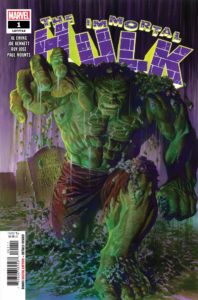 The Immortal Hulk #1 (#718) — Writer: Al Ewing; Pencils: Joe Bennett; Inks: Ruy Jose; Colors: Paul Mounts
The Immortal Hulk #1 (#718) — Writer: Al Ewing; Pencils: Joe Bennett; Inks: Ruy Jose; Colors: Paul Mounts
Deadpool #1 (#301) — Writer: Skottie Young; Art: Nic Klein and Scott Hepburn; Colors: Nic Klein and Ian Herring
Infinity Countdown #4 (of 5) — Writer: Gerry Duggan; Pencils: Aaron Kuder and Mike Hawthorne; Inks: Aaron Kuder, Terry Pallot and Joase Marzan Jr.; Colors: Jordie Bellaire
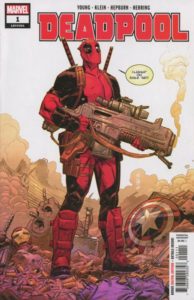 Immortal Hulk has been presented as a horror comic (and in fact Ewing sets up, and Bennett delivers, on at least three casually-terrifying scenes), but it’s more of a tribute to the early-Peter-David-era Hulk: a chilling combination of smart, nasty and violent. That run’s worth emulating because it lasted twelve years, and whether this one lasts for that long, or just for a year, the creators seem to be having a lot of fun trying to top it. In the last volume of Deadpool, writer Gerry Duggan’s final issue wiped the mercenary’s memory; that leaves the writer of the newest version, Skottie Young, with a streamlined, continuity-light character easily recognizable to fans of the movie; as Young shows in his creator-owned I Hate Fairyland, he’s very good at combining light
Immortal Hulk has been presented as a horror comic (and in fact Ewing sets up, and Bennett delivers, on at least three casually-terrifying scenes), but it’s more of a tribute to the early-Peter-David-era Hulk: a chilling combination of smart, nasty and violent. That run’s worth emulating because it lasted twelve years, and whether this one lasts for that long, or just for a year, the creators seem to be having a lot of fun trying to top it. In the last volume of Deadpool, writer Gerry Duggan’s final issue wiped the mercenary’s memory; that leaves the writer of the newest version, Skottie Young, with a streamlined, continuity-light character easily recognizable to fans of the movie; as Young shows in his creator-owned I Hate Fairyland, he’s very good at combining light 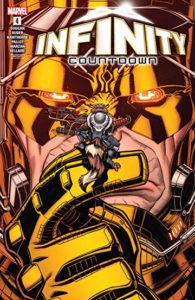 fantasy with murderous cartoony violence, and he puts that very specialized skill to use here. Infinity Countdown sees one major cosmic-character relationship reset to its factory settings, and lots of scrambling over who gets which Infinity Stones, even as it keeps counting down to an even-more-infinite event next month. It’s fine; although a couple of Warlock pages near the end, I think by Hawthorne, don’t do the character much justice (in fairness, it’s hard to think of anyone other than Gil Kane and Jim Starlin who’s really made him look good); a bunch of characters and plot threads get moved around efficiently and advanced clearly, and this offers a good-enough chunk of the ongoing narrative to bring readers back for more.
fantasy with murderous cartoony violence, and he puts that very specialized skill to use here. Infinity Countdown sees one major cosmic-character relationship reset to its factory settings, and lots of scrambling over who gets which Infinity Stones, even as it keeps counting down to an even-more-infinite event next month. It’s fine; although a couple of Warlock pages near the end, I think by Hawthorne, don’t do the character much justice (in fairness, it’s hard to think of anyone other than Gil Kane and Jim Starlin who’s really made him look good); a bunch of characters and plot threads get moved around efficiently and advanced clearly, and this offers a good-enough chunk of the ongoing narrative to bring readers back for more.
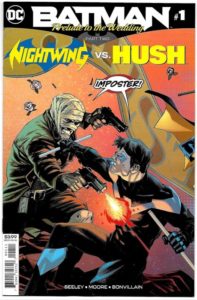 Batman: Prelude to the Wedding: Nightwing vs Hush #1 (of 1) — Writer: Tim Seeley; Art: Travis Moore with Otto Schmidt; Colors: Tamra Bonvillain
Batman: Prelude to the Wedding: Nightwing vs Hush #1 (of 1) — Writer: Tim Seeley; Art: Travis Moore with Otto Schmidt; Colors: Tamra Bonvillain
Batman #48 — Writer: Tom King; Art: Mikel Janin; Colors: June Chung
The Man of Steel #2 (of 6) — Writer: Brian Michael Bendis; Art: Doc Shaner, Steve Rude and Jay Fabok; Colors: Alex Sinclair
Justice League #1 — Writer: Scott Snyder; Pencils: Jim Cheung; Inks: Mark Morales; Colors: Tomeu Morey
 Of DC’s big two characters, Batman gets a little more attention in this week’s books, with his wedding fast approaching. Batman: Prelude to the Wedding: Nightwing vs Hush #1 pretty much tells you everything you want to know about it in its title — although there’s a lot of Superman in it, too, as Clark prepares a bachelor party for Bruce, the title bad guy shows up, and stuff happens; it’s well-enough told, and it manages to add some info about the approaching nuptials while putting the characters through their paces and setting up a future plot point or two. It’s the main Batman title where the action really occurs, though, as the Joker, peeved at his lack of an invitation to the big event, kills a whole church full of people to get his adversary’s attention. King, as you might
Of DC’s big two characters, Batman gets a little more attention in this week’s books, with his wedding fast approaching. Batman: Prelude to the Wedding: Nightwing vs Hush #1 pretty much tells you everything you want to know about it in its title — although there’s a lot of Superman in it, too, as Clark prepares a bachelor party for Bruce, the title bad guy shows up, and stuff happens; it’s well-enough told, and it manages to add some info about the approaching nuptials while putting the characters through their paces and setting up a future plot point or two. It’s the main Batman title where the action really occurs, though, as the Joker, peeved at his lack of an invitation to the big event, kills a whole church full of people to get his adversary’s attention. King, as you might 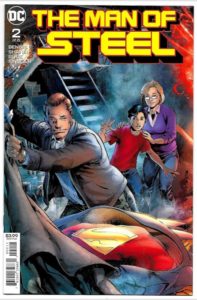 expect, does a great Joker: crazy, casually homicidal and surprisingly well-prepared for an agent of chaos; this bloody-minded fun should be catnip for any regular bat-fan. Moving from Gotham to Metropolis, everyone’s been curious about how Brian Bendis will handle his new scripting duties on both Superman titles, and his introductory weekly mini-series Man of Steel, while not head-turning, should leave wary readers hopeful: the characters look and sound right, the mysteries and sub-plots bubble along nicely, and, despite elements like the disappearance of Lois and Jon, there’s no hint that the current foundations of the book will actually change: it’s just a briskly-told, satisfying installment of the overall story (if Lois gets reality-altering powers and goes crazy and the book’s title changes to Superman Disassembled, then maybe we’ll need to talk…). An even-bigger buzz
expect, does a great Joker: crazy, casually homicidal and surprisingly well-prepared for an agent of chaos; this bloody-minded fun should be catnip for any regular bat-fan. Moving from Gotham to Metropolis, everyone’s been curious about how Brian Bendis will handle his new scripting duties on both Superman titles, and his introductory weekly mini-series Man of Steel, while not head-turning, should leave wary readers hopeful: the characters look and sound right, the mysteries and sub-plots bubble along nicely, and, despite elements like the disappearance of Lois and Jon, there’s no hint that the current foundations of the book will actually change: it’s just a briskly-told, satisfying installment of the overall story (if Lois gets reality-altering powers and goes crazy and the book’s title changes to Superman Disassembled, then maybe we’ll need to talk…). An even-bigger buzz 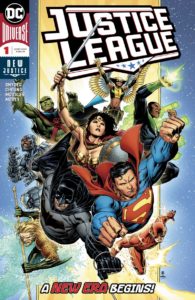 might be building around Scott Snyder and Jim Cheung’s new Justice League, and deservedly so: the book’s cover has Bruce and Clark (and Diana) firmly at center stage, with a membership roster including J’onn J’onzz as chairman, Hawkwoman and the John Stewart Green Lantern. The story itself opens at top speed, quickly recaps how the events of Dark Nights: Metal had an ominous effect on the DC multiverse (short version: it’s got a year to live…), introduces a number of moving parts, and even stirs in some nostalgia for readers of a certain TV-cartoon age, including a new Hall of Justice and, inevitably, a Legion of Doom: like the other books in this grouping, it’s essential if you’re any kind of regular DC reader.
might be building around Scott Snyder and Jim Cheung’s new Justice League, and deservedly so: the book’s cover has Bruce and Clark (and Diana) firmly at center stage, with a membership roster including J’onn J’onzz as chairman, Hawkwoman and the John Stewart Green Lantern. The story itself opens at top speed, quickly recaps how the events of Dark Nights: Metal had an ominous effect on the DC multiverse (short version: it’s got a year to live…), introduces a number of moving parts, and even stirs in some nostalgia for readers of a certain TV-cartoon age, including a new Hall of Justice and, inevitably, a Legion of Doom: like the other books in this grouping, it’s essential if you’re any kind of regular DC reader.
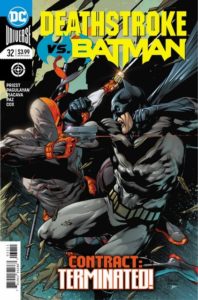 Deathstroke #32 — Writer: Christopher Priest; Pencils: Carlo Pagulayan and Roberto Viacara; Breakdowns: Larry Hama; Inks: Jason Paz; Colors: Jeromy Cox
Deathstroke #32 — Writer: Christopher Priest; Pencils: Carlo Pagulayan and Roberto Viacara; Breakdowns: Larry Hama; Inks: Jason Paz; Colors: Jeromy Cox
The Unexpected #1 — Writer: Steve Orlando; Pencils: Ryan Sook and Cary Nord; Inks: Mick Gray and Wade von Grawbadger; Colors: FCO Plascencia
The Curse of Brimstone #3 — Writer: Justin Jordan; Art: Philip Tan; Colors: Rain Beredo
Deathstroke could have been in that previous grouping, too, since it’s in the middle of a big Deathstroke/Batman six-part fight, involving a possible bombshell: that Damian Wayne is actually the child of Talia Al Ghul and Slade Wilson. Of course, with two such 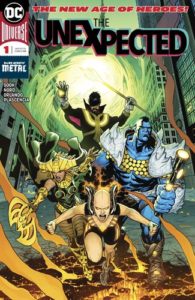 brainy and obsessively-prepared adversaries (not to mention writer Christopher Priest, who’s known for his dense, twisty plotting), there are so many moves, counter-moves, triple-crosses, switchbacks and reversals that, with three issues still to go, there’s no telling where things will eventually end up — which, of course, is a big part of the fun. The Unexpected‘s cover and title made me think it was going to involve a team-up of DC’s magical/supernatural characters, but no such luck – it’s part of their “New Age of Heroes” line, and has (a) decent-looking art covering (b) a bunch of characters you’ve never heard of, many of whom die, who are involved in a shadowy multiversal struggle that’s been going on forever; if you liked the previous “NAofH” title, Immortal Men — well, this is pretty much the same thing. Curse of Brimstone is part of the same line, but, after three issues, has developed its own style: Philip Tan’s dark-edged art was made for this tale of a
brainy and obsessively-prepared adversaries (not to mention writer Christopher Priest, who’s known for his dense, twisty plotting), there are so many moves, counter-moves, triple-crosses, switchbacks and reversals that, with three issues still to go, there’s no telling where things will eventually end up — which, of course, is a big part of the fun. The Unexpected‘s cover and title made me think it was going to involve a team-up of DC’s magical/supernatural characters, but no such luck – it’s part of their “New Age of Heroes” line, and has (a) decent-looking art covering (b) a bunch of characters you’ve never heard of, many of whom die, who are involved in a shadowy multiversal struggle that’s been going on forever; if you liked the previous “NAofH” title, Immortal Men — well, this is pretty much the same thing. Curse of Brimstone is part of the same line, but, after three issues, has developed its own style: Philip Tan’s dark-edged art was made for this tale of a  small-town kid who gets tricked into a deal with a devil and ends up with supernatural-fire-fueled flame powers that will burn down the whole world if he isn’t careful. Justin Jordan’s script keeps its focus on the kid, his sister, the town, the devil and his assistant; it manages the trick of seeming to take enough time to make each plot development and relationship clear (the sister’s function as a voice of reason is particularly good, although those types of characters usually end up with great big targets on their backs…), while still mixing in plenty of action; if you have a phobia about fire, this isn’t your comic, but aspiring arsonists, and anyone else who appreciates flame-based effects, should like it just fine.
small-town kid who gets tricked into a deal with a devil and ends up with supernatural-fire-fueled flame powers that will burn down the whole world if he isn’t careful. Justin Jordan’s script keeps its focus on the kid, his sister, the town, the devil and his assistant; it manages the trick of seeming to take enough time to make each plot development and relationship clear (the sister’s function as a voice of reason is particularly good, although those types of characters usually end up with great big targets on their backs…), while still mixing in plenty of action; if you have a phobia about fire, this isn’t your comic, but aspiring arsonists, and anyone else who appreciates flame-based effects, should like it just fine.
 Sword Daughter #1 — Writer: Brian Wood; Art: Mack Chater; Colors: Jose Villarrubia
Sword Daughter #1 — Writer: Brian Wood; Art: Mack Chater; Colors: Jose Villarrubia
Death or Glory #2 — Writer: Rick Remender; Art/Colors: Bengal
Red Sonya/Tarzan #2 — Writer: Gail Simone; Art: Walter Geovani; Colors: Adriano Augusto
Koshchei the Deathless #6 (of 6) — Writer: Mike Mignola; Art: Ben Stenbeck; Colors: Dave Stewart
 Strangers in Paradise XXV #4 (of 12) — Creator: Terry Moore
Strangers in Paradise XXV #4 (of 12) — Creator: Terry Moore
Sword Daughter is Brian Wood returning to the Norse world of the first millennium AD that he’s covered extensively in Northlanders and, more recently, Black Road; it’s about exactly what it says it is — a young girl and her father are the sole survivors of a slaughtered village; with the father’s spirit shattered, the girl must take matters into her own hands — and if you liked those earlier works, 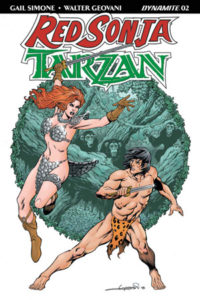 with their extensive research and strong characterization, then you should like this too. Death or Glory is Rick Remender’s new series, also about a girl trying to protect her father, but here he needs an extensive operation, they have no money, and she ends up trying a heist and getting entangled with corrupt sheriffs and human traffickers in, of all places, Yuma, Arizona; besides Remender’s usual combination of action, suspense and humor, there’s the Bengal art: his plastic manga style is just right for both the violence and the sharp-edged comedy, and a big reason
with their extensive research and strong characterization, then you should like this too. Death or Glory is Rick Remender’s new series, also about a girl trying to protect her father, but here he needs an extensive operation, they have no money, and she ends up trying a heist and getting entangled with corrupt sheriffs and human traffickers in, of all places, Yuma, Arizona; besides Remender’s usual combination of action, suspense and humor, there’s the Bengal art: his plastic manga style is just right for both the violence and the sharp-edged comedy, and a big reason 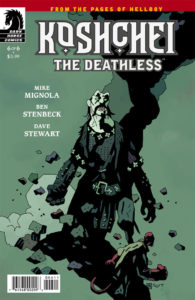 why the first issue of this sold out. Red Sonya/Tarzan is worth a look because of writer Gail Simone, who manages to get the two title characters together thanks to their mutual desire for revenge against a time-travelling hunter/despot who’s pure evil; watching Sonya deal with early-20th-century England is fun, as is the expanding backstory, doled out piece by piece as we need it, and the introduction of a very logical real-life character from that era to help deal with the sf/time displacement bits. Koshchei The Deathless, here in its final issue, is almost more of a Hellboy story than a Koshchi one — but, since it’s written
why the first issue of this sold out. Red Sonya/Tarzan is worth a look because of writer Gail Simone, who manages to get the two title characters together thanks to their mutual desire for revenge against a time-travelling hunter/despot who’s pure evil; watching Sonya deal with early-20th-century England is fun, as is the expanding backstory, doled out piece by piece as we need it, and the introduction of a very logical real-life character from that era to help deal with the sf/time displacement bits. Koshchei The Deathless, here in its final issue, is almost more of a Hellboy story than a Koshchi one — but, since it’s written 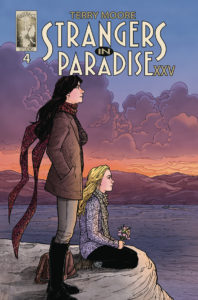 by Mike Mignola himself, that’s all the more reason to check it out; it offers a bridge between Hellboy back in the real world with the B.P.R.D., as he is in current issues of their title, and in his previous residence in Hell, which is where he’s been talking with Koshchei; if you’re a fan of the Mignolaverse you ignore it at your peril. Strangers in Paradise continues Terry Moore’s 25th-anniversary mini-series sequel to the comic that made his reputation. If you’ve read that earlier series, then you’re already reading this one; if not, use it as a sampler, and when it hooks you go binge-read the trades that collect the hundred-plus issues of the original series before coming back to this one — it’ll make more sense, and you’ll have read a ’90s series that’s influenced many of today’s creators.
by Mike Mignola himself, that’s all the more reason to check it out; it offers a bridge between Hellboy back in the real world with the B.P.R.D., as he is in current issues of their title, and in his previous residence in Hell, which is where he’s been talking with Koshchei; if you’re a fan of the Mignolaverse you ignore it at your peril. Strangers in Paradise continues Terry Moore’s 25th-anniversary mini-series sequel to the comic that made his reputation. If you’ve read that earlier series, then you’re already reading this one; if not, use it as a sampler, and when it hooks you go binge-read the trades that collect the hundred-plus issues of the original series before coming back to this one — it’ll make more sense, and you’ll have read a ’90s series that’s influenced many of today’s creators.



